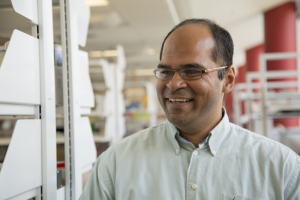Faculty members in the University of Houston Cullen College of Engineering are no strangers to blazing trails – and Ravi Birla, associate professor of biomedical engineering, is no exception.
Birla is blazing trails of his own by publishing his first book, “Introduction to Tissue Engineering: Applications and Challenges.” The book is the first of its kind, offering a comprehensive guide to entering into the field of artificial organ development. Biomedical engineering founding chair and professor Metin Akay served as a series editor on the book as well.
According to Birla, there are some published books on the subject of growing artificial organs and tissues, but many of these are either out of date or serve as a collection of articles written by different researchers rather than as an instructional guide that students or individuals entering the field can follow. “These books are written by different authors, and you really can’t use them for teaching,” Birla explained. “It’s highly inconsistent in terms of who is saying what, and they’re designed to be read by professionals who are already very familiar with the field of growing and engineering artificial organs.”
Birla’s book, however, was written with undergraduate and early graduate students in mind, providing an accessible and easy-to-follow overview of how to synthesize artificial organs in a laboratory. To simplify this highly complex field of research into a guide that’s accessible to entry-level engineers, Birla broke down his tissue engineering process into eight steps, each with their own designated chapter. Though the book wasn’t officially published until this month, Birla used the draft manuscript of his book to teach his undergraduate students last fall. “They found it easy to read, accessible, enjoyable,” he said, adding that he will be using the published version of the book as the official textbook for his class this fall.
And the publication of his tissue engineering textbook could not have come at a better time, Birla said. “Other institutions in the U.S. and across the globe, particularly in Asia and Europe, are forming new academic departments which have a strong focus on artificial organ fabrication,” Birla explained. As a result, there are many new classes being offered at universities across the globe on the field of tissue engineering. This global growth in the field has spawned a demand for textbooks that can be used for teaching students. “This textbook is designed to meet this growing demand globally,” he said.
Before Birla began working on his book, he taught his tissue engineering courses through PowerPoint presentations which he painstakingly put together by collecting articles on tissue engineering as well as creating slides based off of his many years of laboratory experience. Without any definitive textbook for the field of artificial organ engineering, the education students receive on this topic is extremely inconsistent. “The majority of professors are using articles [to teach], and it’s very different from one institution to another. It’s based on the experience of the individual instructor,” Birla said. In fact, the curriculum for artificial tissue engineering differs so much from one institution to the next that, before Birla published his book, a standard definition of tissue engineering didn’t even exist.
“If you look at what’s happening, [the definition of] tissue engineering is so convoluted,” Birla said. “One of the exercises we went through was to go through some of the prominent definitions, like the National Science Foundation’s and the National Institutes of Health’s definitions, as well as the definitions from some of the early researchers in the area, and based on that we came up with the commonalities of the definition and what the field involves. From that, I proposed a standard definition of tissue engineering.” Birla said he hopes the definition provided in his textbook will become the new standard.
Though the book has only been officially published now for less than three weeks, Birla hopes it will cement a permanent place in tissue engineering classrooms, putting an end to the inconsistencies found across academia. “There is so much flux in the field and so much variation,” he said. “I present [all of the opinions] here and based on all of that, what I think is the right way of doing it. It’s more specific than anything that’s ever been published on the topic of tissue engineering. Students need specifics.”
In addition to bringing some consistency and uniformity to tissue engineering curriculums at universities across the country and the world, Birla said he hopes his textbook will allow for many more young STEM-enthusiasts to enter into this exciting new field.
“I want not only to make this field more accessible to a larger number of people, but I want to help get younger people excited about tissue engineering and about STEM in general,” Birla said. “My hope is that this textbook will introduce some young people to the field in a way that excites them so we have many more talented engineers entering into this field and conducting new research.”
